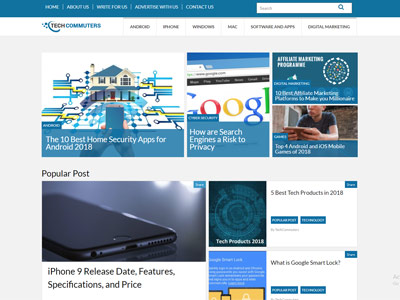The Advancement of the Best tech blog: A Journey With Tech Background and Future Trends
Recognizing the Rise of Side Computing in Today's Digital Globe
In the quickly developing landscape of technology, side computer emerges as an essential pressure, reshaping just how information is refined and utilized. By transitioning data monitoring closer to the source, edge computer addresses critical latency problems while optimizing transmission capacity usage and enhancing safety measures.
What Is Side Computer
Edge computing, although a fairly current innovation in the realm of modern technology, basically changes how information is processed and managed by bringing calculation and information storage space closer to the area where it is required. Unlike typical cloud computing versions, which often count on centralized information facilities that can be geographically far-off, edge computing decentralizes data handling. This closeness reduces latency, boosts real-time information processing, and enhances the overall user experience by guaranteeing much faster response times.
At its core, side computer involves a network of localized devices and facilities, such as routers, gateways, and sensors, qualified of processing data at or near the source. This localized processing ability is especially essential for applications calling for instant information evaluation, such as independent lorries, commercial automation, and clever cities. In addition, by unloading data processing jobs from central servers, side computing decreases data transfer needs and boosts information personal privacy and security, as delicate info can remain on-site rather than traversing extensive networks.

Trick Motorists of Adoption
Several factors are driving the adoption of edge computing in today's electronic landscape. Edge computing addresses this requirement by making it possible for information processing closer to the data source, minimizing latency and boosting real-time decision-making capacities.
Another significant vehicle driver is the need for improved data transfer effectiveness. Central cloud systems can come to be overwhelmed with the large quantity of information produced by IoT tools, leading to bottlenecks (Best tech blog). By refining data at the side, companies can reduce network blockage and boost total system efficiency
In addition, protection and privacy worries are pushing organizations towards side computer. By refining delicate data in your area, firms can minimize threats related to data transmission and exposure to potential cyber hazards.
The surge of applications needing real-time handling, such as self-governing vehicles and boosted truth, likewise necessitates the quick response times that edge computing gives. Jointly, these chauffeurs are making side calculating an important component of modern-day IT framework, leading the way for its extensive adoption throughout various sectors.
Advantages Over Cloud Computer
How does edge computer distinguish itself from typical cloud computer? Mostly, side computer brings information processing closer to the source of data generation, usually on neighborhood devices or close-by web servers, instead than counting on central data.
Additionally, edge computing enhances data transfer efficiency (Best tech blog). By refining data locally, only the required information is sent to the cloud for more evaluation or storage, reducing the volume of data that traverses the network. This not just reduces my site network blockage however likewise lowers data transmission expenses
Edge computer also supplies better data privacy and safety and security. Sensitive information can be refined locally without being sent out to the cloud, minimizing the direct exposure to prospective cyber threats. This is specifically beneficial for fields managing secret information, such as medical care and economic solutions.
In addition, side computing makes certain greater strength and dependability. Regional handling enables continued operation even when connectivity to the cloud is endangered, preserving necessary features and services in spite of possible network disruptions. These benefits jointly show edge computing's transformative possibility in enhancing efficiency and safety in electronic environments.
Considerations and obstacles
While side computer provides numerous benefits, it also offers special difficulties and factors to consider that should be dealt with to totally realize its potential. One considerable difficulty is information protection and privacy. Handling information closer to the source boosts the threat of unapproved gain access to, demanding robust encryption and strict protection protocols to safeguard sensitive information. Additionally, managing and checking a decentralized network of edge tools can be complex, requiring sophisticated tools and approaches to guarantee smooth procedure directory and upkeep.
Another consideration is the scalability of side computing options. As the variety of linked gadgets grows, so does the demand for refining power at the side, which can cause resource restrictions. Organizations needs to meticulously plan their infrastructure to suit this development without endangering performance or efficiency.
Interoperability is another vital element. With various software and hardware components entailed, making sure compatibility and smooth combination can be difficult. Standardization efforts are vital to facilitate interaction in between diverse systems.
Future Fads in Side Computing
Expecting the future, side computing is poised to transform numerous sectors by enabling much faster data processing and decreasing latency. As the volume of data created by IoT gadgets proceeds to grow, edge computing will certainly become significantly important in handling this increase effectively.
An additional arising trend is the development of edge-native applications made particularly to leverage the one-of-a-kind capabilities of side computer. These applications will optimize efficiency and source application, bring about raised efficiency throughout numerous markets. Innovations in 5G modern technology will even more strengthen side computing by offering the needed infrastructure for high-speed, low-latency interaction in between tools and edge nodes.
Final Thought
Side computer's rise is driven by the proliferation of IoT tools and the demand for real-time data handling, which enhances efficiency by lowering latency and decentralizing information monitoring. This approach reduces transmission capacity inadequacies and safety problems, helping with improvements in applications like self-governing lorries and wise cities. Despite difficulties such as infrastructure complexity and combination, the future of edge computer guarantees a more responsive digital community, with continued advancements shaping its development and increasing its applicability across visit site sectors.
Edge computing, although a relatively recent development in the realm of technology, fundamentally changes how data is refined and managed by bringing computation and information storage space closer to the place where it is required. Unlike traditional cloud computing designs, which typically count on central information centers that can be geographically far-off, side computing decentralizes information handling. In addition, by unloading information handling tasks from central web servers, edge computing reduces transmission capacity demands and boosts data personal privacy and safety and security, as sensitive information can remain on-site instead than going across comprehensive networks.
